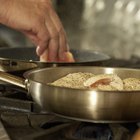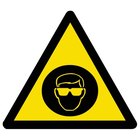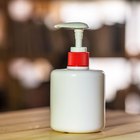
Raw chicken has the potential to spread food borne illnesses if it isn’t properly handled. If you’re working with raw chicken, not only do you have to wash your hands, you have to thoroughly sanitize anything that chicken comes into contact with. Otherwise, you’ll risk contaminating everything else in your kitchen.
Cross Contamination Details
When you touch raw chicken, any bacteria lurking on the meat can stick to your skin. Then when you grab your knife, wipe your hands on the towel or reach over and turn on your faucet, all of those surfaces also become contaminated. Even though you've washed your hands, they’ll just get dirty again the next time you touch your faucet.
Why It’s Dangerous
Raw chicken can carry harmful bacteria, such as salmonella and campylobacter. These types of bacteria could lead to uncomfortable gastrointestinal problems -- like cramping and diarrhea. As a healthy adult, you should be able to recover with time, although the bacteria may be especially detrimental, and even fatal, to young kids or older adults. While not all chicken is contaminated, to be on the safe side, the USDA Food Safety and Inspection Service says that you should always cook poultry to a minimum internal temperature of 165 degrees Fahrenheit.
Proper Handwashing
Rather than turning on the faucet with your bare hands after handling chicken, use your elbow to pry up the faucet. If your faucet has knobs, leave a paper towel out beforehand, so you have it available to turn the faucet on and off. After a quick rinse, use your forearm to push down on the soap dispenser to get soap into your hands. Lather up -- focusing on the backs up your hands, between your fingers and under your nails -- for at least 20 seconds, suggests the Centers for Disease Control and Prevention. Once you’re all clean, rinse and dry your hands.
Cleaning Surfaces
Any surfaces that came into contact with the raw chicken, or that you touched after handling the raw chicken, also need to be sanitized. Rinse all of the dishes under warm water that is at least 110 F. If you have a second compartment, fill it with 110 F water and soap, or if you have a one-compartment sink, empty it out, clean it and fill it with clean hot water and soap for scrubbing. Once everything is clean, rinse off the soap and soak your dishes in hot water that is 171 to 195 F for a minimum of 30 seconds, according to the USDA Food and Nutrition Service. Allow your dishes to air dry. Always sanitize any cabinet knobs, refrigerator door handles or sink handles that might have been contaminated.
Grocery Store Tips
The plastic packaging for the chicken is contaminated with the same bacteria that are on the chicken. The liquid from the raw chicken can leak out onto you or the rest of your groceries -- contaminating everything. Always use a paper towel to grab the package of chicken and place it directly into a plastic bag. If your grocer doesn’t supply paper towels, use a plastic bag to grab the container of chicken.
Related Articles
Does Packaged Chicken Have to Be Washed ...

Is It Safe to Bake Vegetables in the ...

Can I Cook a Whole Chicken Without ...

Can I Cook Chicken That's Been Thawed ...

How to Sterilize Safety Goggles

How to Re-Crisp a Cold Roast Chicken

How to Keep Acrylic Nails Clean

Can You Roast Chicken on Silicone ...

If Chicken Doesn't Smell Bad, Can You ...

Facts About Hand Sanitizers

Can You Boil the Bacteria Out of ...

How Long Can I Keep Frozen Whole ...

How Long Is Cooked Chicken Good?

How to Change a Labret

How to Make Crock-pot Chicken

If Chicken Smells Bad Can You Still ...

How to Bake Frozen & Prebreaded Chicken

How to Take Care of an Eyebrow Piercing

How to Drain a Cheek Piercing

Shared Electric Razor Dangers
References
Writer Bio
Melodie Anne Coffman specializes in overall wellness, with particular interests in women's health and personal defense. She holds a master's degree in food science and human nutrition and is a certified instructor through the NRA. Coffman is pursuing her personal trainer certification in 2015.
Photo Credits
Jupiterimages/Photos.com/Getty Images